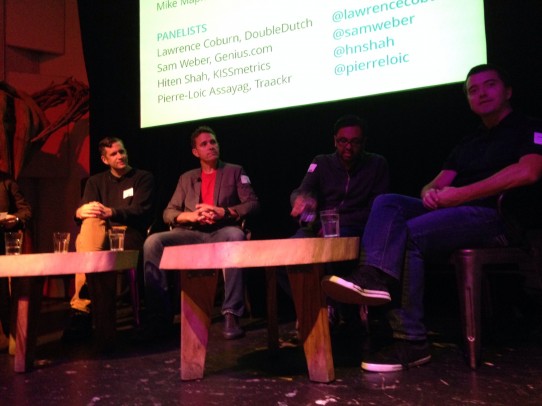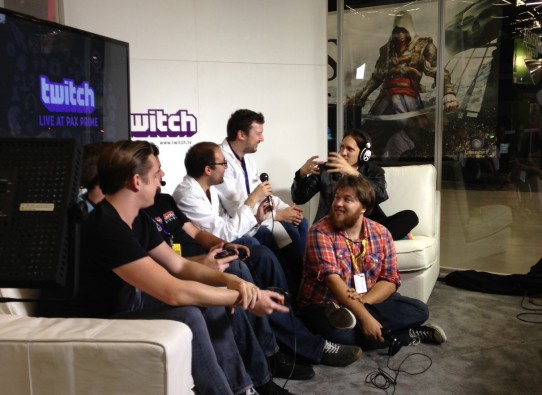
On Tuesday we helped our friends at DoubleDutch put on a panel discussing what’s next in marketing technology and how startups can capitalize on the skyrocketing CMO tech budget. The event was called “The Battle for the Marketing Cloud,” and it was a hit! CEOs from DoubleDutch (social events platform), KISSmetrics (data analytics), Traackr (influencer marketing) and Genius.com (marketing automation) spoke to a packed house of startup founders with insightful moderator Mike Maples, one of the valley’s top notch VC’s and managing partner at FLOODGATE.

Reflecting on the discussion, I’d like to share my top takeaways from the event:
1) The “shift” in budget from the CIO to the CMO is not really a shift.
Since Gartner predicted that the CMO’s tech budget will eclipse the CIO’s by 2017, there has been a lot of hullabaloo about these two positions competing for cash. In reality, that’s not the case. CIO’s aren’t losing money for tech to their colleagues in marketing; CMOs are just rapidly gaining budget because new digital tools are making it easier for them to prove ROI on their spends. A classic marketing problem used to be, “I know half of my advertising budget is working, I just don’t know which half.” Trackable, data-driven tools are increasing transparency into what channels and messages work. Hence, the boom in enterprise marketing-focused startups. (Credit: Mike Maples, @m2jr).
2) Cloud software is democratizing the marketing vendor space.
Cloud software is making it easier for startups to quickly deploy solutions, and therefore, it’s very easy for in-house marketers to try many different tools and evaluate them. While this helps create an even playing field to edge out software incumbents like SAP and Oracle, it also means that your solution could be booted as quickly as it was installed. The bottom line: you can get in relatively simply, but your product must be rock solid to keep its place in a CMO’s tech mix. (Credit: Lawrence Coburn, @lawrencecoburn)
3) Complex marketing sales require buy-in from the CIO.
Even though the cloud makes it easier to sell to the CMO, marketing software sales that span a large enterprise usually require buy-in from the IT department as well. In the case of data analytics platform KISSmetrics, penetrating an organization usually starts with a lower level developer or marketing manager. Then, as the product gains advocates, the KISSmetrics sales team can move up the food chain, eventually working with both the CIO and the CMO to develop the most productive, long-term customer relationships. (Credit: Hiten Shah, @hnshah)
4) Integrating point-based marketing solutions is the next big opportunity.
Because the cloud has created a boom in point-based solutions that focus on solving one marketing problem elegantly, marketers are usually dealing with a number of tools that don’t talk to each other. The next wave of truly “disruptive” solutions will integrate data from all tools – social, automation, email, events and more – into one easy-to-understand platform. This new solution would empower marketers to understand how their channels work together with powerful data visualization. (Credit: Pierre-Loic Assayag, @pierreloic and Sam Weber, @SamWeber).
5) The best companies don’t compete.
Mike Maples had so many insights about what makes a startup remarkable, it was hard to choose just one to highlight. However, my top takeaway from Mike is that the best companies don’t compete at all. They are not trying to be the best in their category; they create categories. In this position, a company should develop a provocative point of view that repels those “villains” who you would rather not have as customers and attracts others that share your spirit. For example, Salesforce ran with the “no software” perspective that drove away slow-moving traditional sales departments and excited those looking for a less clunky CRM service.
In Mike’s opinion, capitalism isn’t about competition, it’s quite literally about gaining capital, and those who are the only force in their particular market segment usually win this battle. (Credit: Mike Maples, @m2jr)
A big thank you to DoubleDutch for sponsoring the event and to Mike Maples, Lawrence Coburn, Hiten Shah, Pierre-Loic Assayag and Sam Weber for participating. You can continue the discussion by downloading the DoubleDutch event app here or tweeting me @DianaHSmith.









